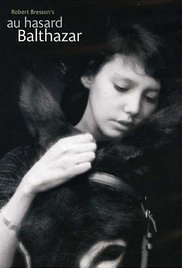Sight & Sound Voyage Entry #35
Placement On Sight & Sound Top 50 Movies List: #16
One of the biggest no-no’s in the world of cinema is hurting animals. Kill all the people you like (so long as they ain’t kids) but hurting an innocent animal? You’ve gone too far. That’s a really understandable phenomenon to me because animals are awesome and the sight of seeing an innocent creature with less capabilities than a human being experiencing pain just feels icky. That’s why I’ve never been big on hunting and that’s why movies have typically eschewed showing animals in dire pain, though there are exceptions of course. Satantango decided to just abuse a poor cat in one of its worst and most pointless scenes while Old Yeller is famous for its climax that results in the demise of the titular canine.
Director Robert Bresson obviously decided to eschew convention in that regard when tackling his 1966 movie Au Hasard Balthazar, which is all about the cruelty human beings put upon innocent animals and their fellow human beings. The titular character of Balthazar is a donkey given to a family at a young age. It’s in his earliest years at this homestead that he forms a close bond with the young girl of the household, Marie (played as an adult by Anne Wiazemsky). The two grow up but they get treated in a manner that even the most generous onlooker would refuse to describe as remotely humane.
Balthazar is handed off from owner to owner, one of which uses his mathematic intellect for monetary gain. Another one of his owners lights his tail on fire just to get him moving. Marie, for her part, is stalked by a childhood friend and his gang, with her childhood friend treating her like an object to be won rather than a person. The movie concentrates on their individual suffering, all presented in a stark black-and-white color scheme that adds a somber layer to the story that clearly takes place in the then modern-day world. All of the struggles these two endure throughout the years are presented by Bresson not in an exploitative manner but rather a tragic one.
He wants the audience to gaze upon sorrow that’s all too common in this world, the abuse suffered by both women and animals. Notice how, for both Balthazar and Marie, all of the misery and abuse put upon them comes from white males, individuals who inherently garner more power in many societies across the globe due to systemically ingrained power structures that unfairly tip the scales in the favor of these particular human beings. In Au Hasard Balthazar, it is those in power that feel they can treat women however they want regardless of the feelings of the woman in question or treat animals like their own slaves instead of living creatures with emotions.
It’s difficult to watch in plenty of sequences, but again. Bresson foregoes the opportunity to come off as just putting women or animals in danger just for cheap shock value. There’s an underlying purpose to the nihilistic story he’s telling. In terms of any underlying ideas contained in that story, it’s worth mentioning that, prior to watching Au Hasard Balthazar, I read on, I think Scott Derrickson’s Twitter page, the concept of the character of Balthazar being a stand-in for Jesus Christ in this movie, a pure figure navigating a world of hatred and abuse directed at him specifically. An interesting idea I kept in mind during my first viewing of this motion picture that totally works in the feature itself.
While we’re talking about the donkey, though it may sound like a joke, the animal playing Balthazar here is one of the better animal actors I’ve seen in a while and Bresson also gets major praise from me for staging scenes or shots where Balthazar is being kicked or abused in a way that makes it clear the human actors aren’t hurting a real animal, there’s plenty of gripping drama in the movie, you don’t need to resort to cheap exploitative tactics like animal abuse as a substitute for actual depth. Most of all though, when it comes to Balthazar, I really just adore how the script handles his character. The screenplay (penned by Robert Bresson) doesn’t give him these overly personified quirks that would break the naturalistic atmosphere of the movie. Instead, he’s depicted as simply a normal animal, one whose instantly likeable and garnering sympathy from the moment the adorable young version of the character pops up on-screen. It’s doubtful that level of emotional investment would have occurred if they had gone down the Racing Stripes route and made our lead character a wacky talking animal or incorporated any other stylized traits.
Like Balthazar, Marie is a well-formed creation that garners a lot of sympathy from enduring a lot of grievances women in society are forced to suffer through, namely the unwanted advances of a creep who refuses to take “No” for an answer. Like Balthazar being portrayed as just a normal donkey, Marie’s troubles are depicted in a subdued manner that breaks your heart, as it’s obvious she’s trying to keep her composure whilst emotionally experiencing so much turmoil. This scene early on in the third act where she goes into a stable Balthazar is sleeping in and tells the owner about her loneliness and woes, I found myself getting both teary-eyed and amazing at the level of bleak emotional power a movie like Au Hasard Balthazar can command.

